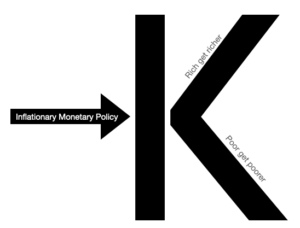
Some of the most prominent explanations of the cause of inflation can be extremely confusing and often end up leading the reader/inquirer to conclude “Ahh, it’s just too complicated. We can’t really put our finger on it, and there are many different factors.” In this post, I aim to undo that surrender of understanding and replace it with a simple, accurate explanation.
What is inflation?
Inflation is the steady, continual rise in the price of goods. It is typically measured using a “basket of goods”. In this approach, the prices of many different goods are tracked and then integrated using some sort of logical weighting calculation.
The Cause… Theory #1 – Demand-Pull Inflation
“Too much money chasing too few goods”. This is the theory that says inflation is caused by demand out pacing supply. Believers of this theory pat themselves on the back about inflation as if it is evidence of a growing economy. This kind of fantastical belief is possible only through naivety. A global review of inflation teaches us that some of the most rapid inflation occurs in economies that aren’t growing at all. Conclusion: False.
The Cause… Theory #2 – Cost-Push Inflation
“When companies’ costs go up, they have to raise their prices to maintain a profit margin.” This may explain fragmented price fluctuations, but remember that inflation is the steady rise in price of goods (in general). If prices are stable across the board, but wheat spikes in price, it won’t single handedly result in substantial inflation. Even if wheat is in the “basket of goods” that we use to calculate inflation, its rise in price will minimally affect the overall computation for inflation. Another thing to note is this: What is causing the companies costs to go up? The Cost-Push Inflation theory is almost like saying “Rising prices are caused by rising prices”. Huh? Conclusion: False.
Supply & demand of goods have nothing to do with inflation. Let’s look at the rising price of oil, and examine Demand-Pull and Cost-Push theory. Whether it’s because of an increase in demand, a decrease in supply or a combination of both… if Americans are spending more money at the gas pump, they have less left over for buying jewelry and dining out. All other things being equal, the price of jewelry and restaurant dining will go down because of its lowered demand caused by increased price of oil. The net effect is that in the “basket of goods” inflation calculation, oil prices rose, while prices of other items declined… and inflation is generally unaffected by theories 1 & 2.
The Cause… Theory #3 – Monetary Debasement
Imagine that tomorrow everyone wakes up with double the amount of money we had today. The companies who sell goods and services to us will discover that we will bear higher prices. This will cause prices to eventually double. If this happens once it isn’t inflation per se because it’s not continual. But if this happens every night, it will create inflation.
Unfortunately for American citizens (and anyone who earns or spends in US dollars) this monetary debasement doesn’t merely happen by each of us waking up each morning with more money. It happens from two central banking phenomena:
Phenomenon # 1 – Fed’s Digital Printing. In our economy, we use money created by a private bank, the Federal Reserve (abbr. “Fed”). When we came off the gold standard in 1971, our money’s ties to commodities were severed. Since that point, most money has simply been a blip on a financial statement, and more recently, blips in cyberspace.
Example: The Fed buys $50 million worth of U.S. bonds from its member bank, ABC Bank. The Fed credits ABC bank with money for the sale of the U.S. bonds. What account does this come from? A magical one. ABC Bank is credited with $50 million, but there is no corresponding Fed account that is debited $50 million. This is the Fed “printing money”. People talk all the time about how the Fed could print money, but few realize it’s actually happening all the time, and inflation is evidence of it.
Phenonmenon # 2 – Fractional Reserve Banking
Another equally magical way money is created is by fractional reserve banking. In this system, we can borrow money that doesn’t exist. If you deposit $1 into a U.S. bank, $7 (that did not exist) can be lent out. Often when money is borrowed it is then deposited into another bank account, meaning that only two levels into this set of transactions, $1 can turned into $49. Our banking system allows for money to be created simply by a person, corporation, or government borrowing money from a bank. That money is then brought out into circulation, and our prices go up. Because we didn’t wake up ourselves with more money, we essentially become victims of inflation. We didn’t get more money, but we do face higher prices. The benefit of inflation is only enjoyed by the banking system that earns interest on the money that was created at the exact moment it was lent and borrowed.
Almost as important in monetary history as coming off the gold standard is the 2006 Fed decision to stop publishing its “M3” statistic. This is the report that tells us how about much new money is being created each year. Their last report (around March 2006) said that our money supply was increasing by about 8% per year. Independent sources have attempted to mimic M3 reports since Fed’s M3 discontinuation and are currently reporting annual money supply increases of 16%.
Simply put: monetary debasement (an increasing money supply) creates inflation.
Difficult to swallow, but easy to understand.


